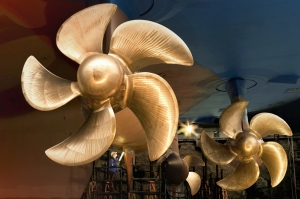


(Posted on 09/06/21)
As Azipod propulsion enters its fourth decade of production, the latest episode of the ABB DECODED podcast explores the technology that is revolutionizing the maritime industry beneath the waves, with engineers Jukka Varis and Ole-Jacob Irgens.
ABB’s Azipod propulsion system has brought huge advances to the maritime industry, thanks to its efficiency gains, sustainability benefits and the increased maneuverability it offers any ship to which it’s fitted.
Jukka Varis – responsible for this technology globally, who has worked with the system from the very beginning – and Ole-Jacob Irgens – an engineer by training, who now leads the sales and marketing initiative for ABB’s Azipod system – share their experiences and knowledge.
Azipod propulsion is a gearless steerable propulsion system where the electric drive motor is housed within a pod outside the ship hull. Originally developed for icebreaking vessels, the Azipod® system can be adapted to suit almost any kind of ship. Today, over 25 different vessel types rely on Azipod technology – from cruise ships to cargo carriers, icebreakers, ferries and superyachts.
Jukka explains: “Azipod system looks similar to an outboard motor but is much bigger – the large unit weighs as much as a fully loaded Jumbo Jet. It can turn 360 degrees around its axis, creating thrust in any direction and resulting in much better maneuverability of the vessel.”
Electrical power minimizes engine noise and vibration, ensuring a smoother, quieter ride.
The true efficiency benefits of Azipod propulsion have become more and more apparent over the past three decades, bringing higher performance, reliability and sustainability for vessels.
Azipod system cuts fuel consumption by up to 20 percent compared to conventional shaftline propulsion. Ole-Jacob adds: “Since the first installation on a cruise ship 25 years ago, we have estimated that the industry has saved more than 1,000,000 tons of fuels from these cruise ships alone.”
Azipod propulsion has also opened opportunities for new shipping lanes that weren’t feasible before, such as the Northern Sea Route, cutting fuel consumption while negating the need for separate icebreaker assistance.
Ole-Jacob explains: “Vessels can have a shorter route between Europe and Asia, saving many days in transport. To do that, you need vessels which can go through ice, something the unique features of Azipod enable.”
Leading vessel performance platform Smart Ship Hub says the industry should expect a breakthrough year... Read more
The Nordic countries are taking an important step towards decarbonising maritime transport with the... Read more
Germany’s Steelpaint has appointed ADD Marine as its representative for Greece and Cyprus, strengthening... Read more
Rio Tinto’s first Pilbara-made iron ore rail car has rolled off the production line in Karratha... Read more
Precision meets progress at Phu My Port, Vietnam. The LPS 550 has been deployed to handle bulk commodities... Read more
bound4blue, a global leader in wind propulsion systems, has expanded its industrial footprint in Asia... Read more
As the industry explores multiple decarbonisation pathways, methanol is gaining attention as a practical... Read more
Technology group Wärtsilä will supply an integrated hybrid propulsion system for a bulk carrier... Read more
Superior Industries, Inc., a US-based manufacturer and global supplier of bulk material processing and... Read more
ESL Shipping has taken a significant step forward in digitalisation by deploying a new multichannel... Read more